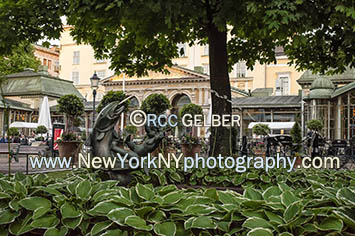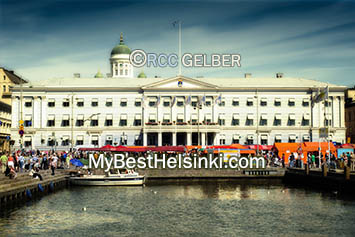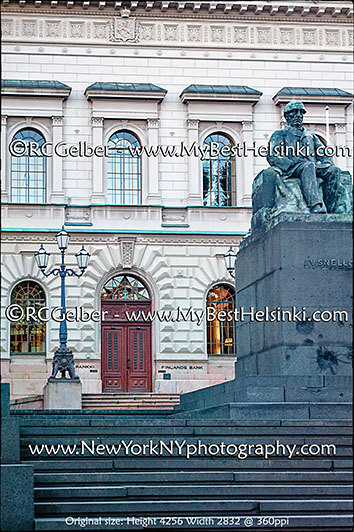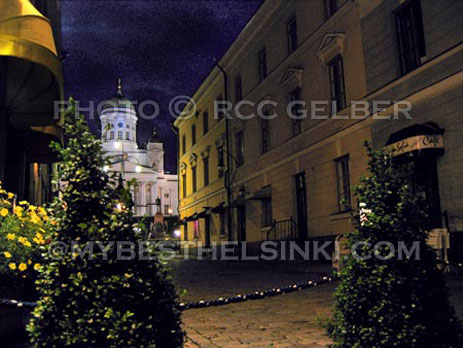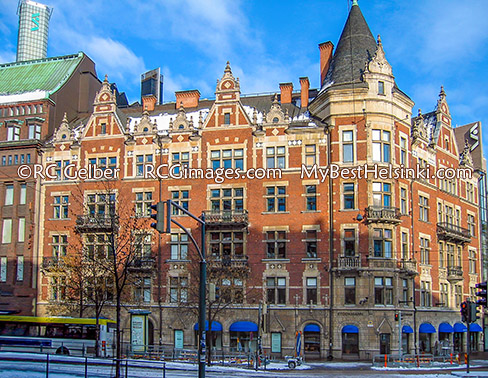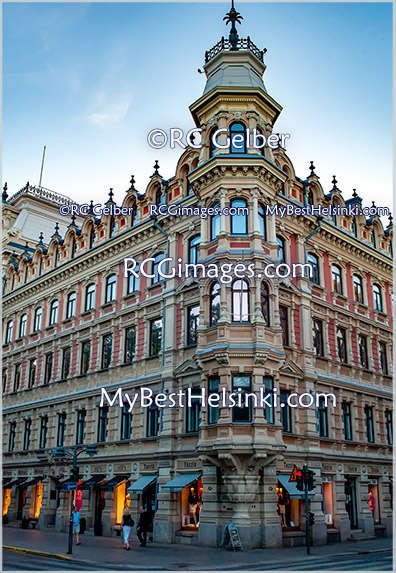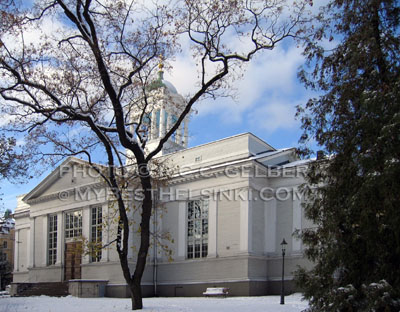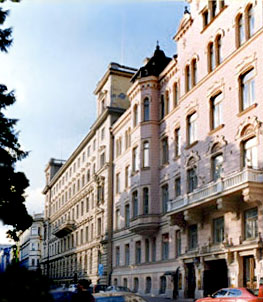Welcome to My Best Helsinki - Architecture in Helsinki
Kruununhaka Senate Square Market Square Töölö Bay Katajanokka Kaartinkaupunki Kluuvi Kamppi Töölö interesting links
THIS DOMAIN NAME AND WEBSITE ARE FOR SALE.
EMAIL GelberLaw@aol.com for details.
Put "My Best Helsinki" in the subject line.
For a small and relatively "young" city, Helsinki sure has managed to gather many different styles of architecture within its center. Neo- Classical (Empire style), Neo-Renaissance; everything from Art Nouveau ("Jugend"), which morphed into National Romanticism (National Romantic Style) to Nordic Classicism, Functionalism to Modernism. There is even a stunning example of the Russian-Byzantine style, and a magnificent Neo-Gothic style stone church. Brief history of Helsinki | Helsinki & Finland in numbers. Helsinki looked more like a village until the end of the 18th
century and its buildings were mostly built of wood. The City suffered several devastating fires in the 17th and 18th centuries and the 1808 fire destroyed a third of Helsinki. Helsinki became the capital of the Finnish Grand Duchy in 1812. A large ebuilding plan was created. In a couple of decades a new Neo-Classical (Empire style) center was erected in the place of the old wooden buildings. - Fastfoward to year 2009 and you will see a city that is one of the fastest changing cities in Europe.
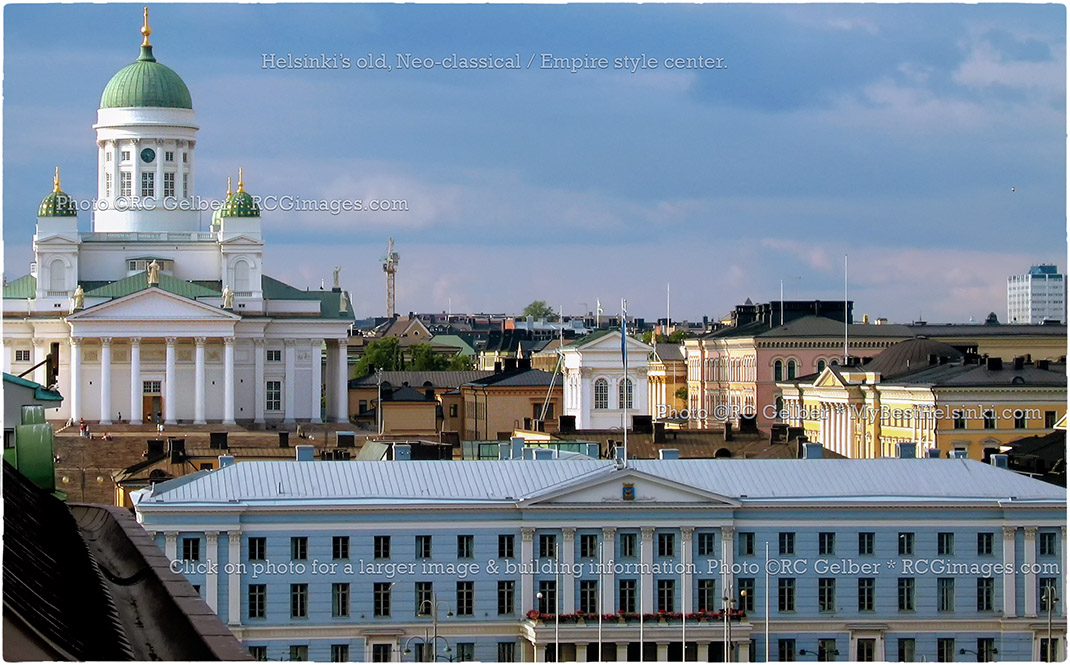
Most photos on My Best Helsinki can be viewed in a larger format by clicking on the photos. Please see the copyright notice on the bottom of the page. Legal notice about unauthorized copying and / or posting of our images. interested in buying our images? Please contact us. Thank You.
THE SENATE SQUARE AREA - THE OLD "EMPIRE CENTER" OF HELSINKI:
NEO-CLASSICAL (EMPIRE STYLE) ARCHITECTURE is well represented in the center of Helsinki, especially in the Senate Square, below, with its three dominant buildings, all designed by Carl Ludwig Engel.
From left to right:
1) Helsinki University main building. ( Hover here for brief building info. .)
2) the Lutheran Dome, and
3) the Government Palace
- Valtioneuvoston Linna:
(Hover for Building Info). | Images on Wikipedia.
A fantastic link to the arhcheological history of the Government Palace.  The statue of Emperor Alexander II stands in the center of the square. It was erected in 1894 to commemorate his re-establishing the Diet of Finland (the legislative assembly
of the Grand Duchy of Finland from 1809 to 1906; in Finnish "Maapäivät", now "Valtiopäivät".) in 1863, and establishing many reforms increasing Finland's autonomy from Russia.
The statue of Emperor Alexander II stands in the center of the square. It was erected in 1894 to commemorate his re-establishing the Diet of Finland (the legislative assembly
of the Grand Duchy of Finland from 1809 to 1906; in Finnish "Maapäivät", now "Valtiopäivät".) in 1863, and establishing many reforms increasing Finland's autonomy from Russia.
More images (more recent & larger) of buildings around the Senate Square on our Photo Page 3.
Engel also redesigned the 18th century central government buildings, located on the south side of the Senate Square, to better fit in with the general design of the square.
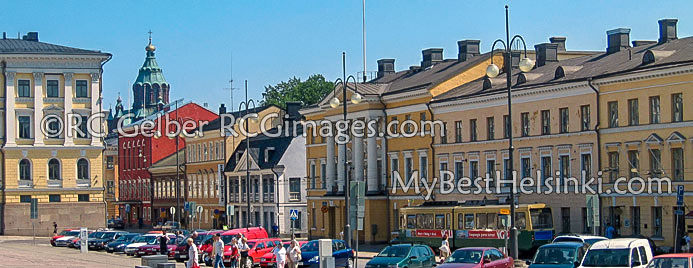 Click on photo for information about the different buildings surrounding the square
Click on photo for information about the different buildings surrounding the square
Information
about The Government Palace.
In
Finnish = Valtioneuvoston Linna (Literal
translation: the Palace of the
Council of State).
An interesting
1865 photo of the
Senate Square area,
with the Dome.
The National Library of Finland.
The City Hall, one block south, on
Pohjoisesplanadi,
was also designed by Engel. 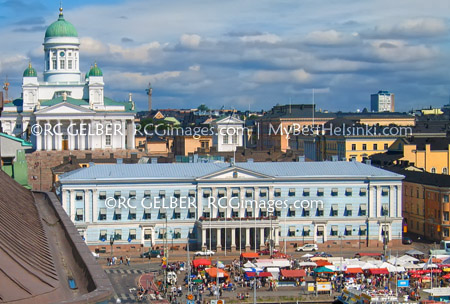
Built in 1833.
second link |
The Helsinki Dome in bgr. Many more Helsinki Dome images on our home page and on our Photos 3 - page.
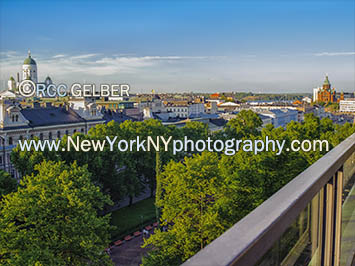
Late summer eve view of Helsinki historic center, over Esplanade Park to the Uspenski Cathedral in Katajanokka neighborhoood and the Helsinki Dome (Helsinki's Lutheran Cathedral) by the Senate Square on the left. 2nd link | Wikipedia info & pics
Left & below: Bank of Finland - Suomen Pankki.
Location:
Snellmaninaukio, Kruununhaka, Helsinki.
Architect: Ludwig Bohnstedt. Main building finished in 1883. Style: Italianate Renaissance.
The Bank of Finland was established on 1 March in 1812 (in Turku) by Alexander I.
In 1819 it relocated to Helsinki. The Bank created and regulated the Finnish Mark (Markka) until Finland adopted the euro in 1999.
Source & more information: Wikipedia
Interesting pdf-file about the history of Bank of Finland (and the architect). It also contains interesting images and drawings:
In English -
In Finnish
Virtual booklet of the same brochure:
In English -In Finnish
Scrolling Virtual Tour of the Bank of Finland’s art collection. You can click on each i-link to get more information of the work in question.
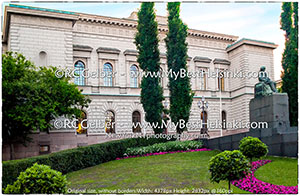
The Statue in front of Bank of Finland is that of Johan Vilhelm Snellman: Finnish statesman, philosopher, university docent, journalist, author - and one of
the most
influential Fennomans in the
1800s. He was ennobled in 1866. He had considerable influence on the significance of the Finnish language and the
introduction of the Finnish
mark.
He is hailed as Finland’s national philosopher and one of the most important driving forces for the Finnish national cause.
Second, short link about the Fennoman movement.
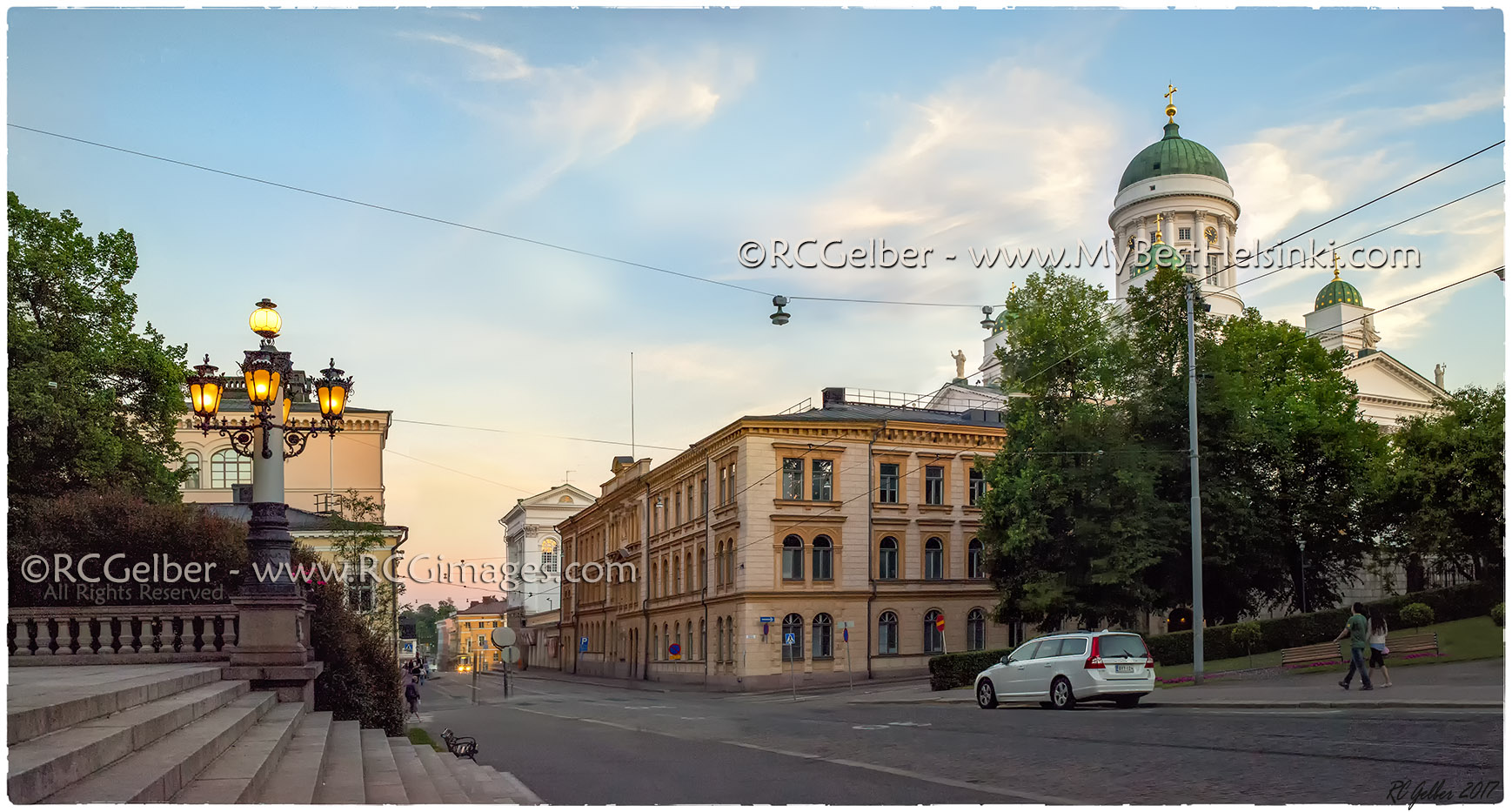
Above: Midnight sun - end of June. From left to right: The steps to the House of the Estates. To the right, the Helsinki Cathedral, a.k.a. as the Lutheran Dome. The couple walking down the street have just passed the Bank of Finland - building. Looking down along Snellmaninkatu (Snellman’s Street) toward the Senate Square (where the tram has stopped). Past the tram and down the street, you will arrive at the South Harbor Market Square (to the left) and one end of the Esplanade Park. That whole surrounding area is now called the Tori Korttelit / Quarters (The Market Square Quarters).
Click on photo for larger view..
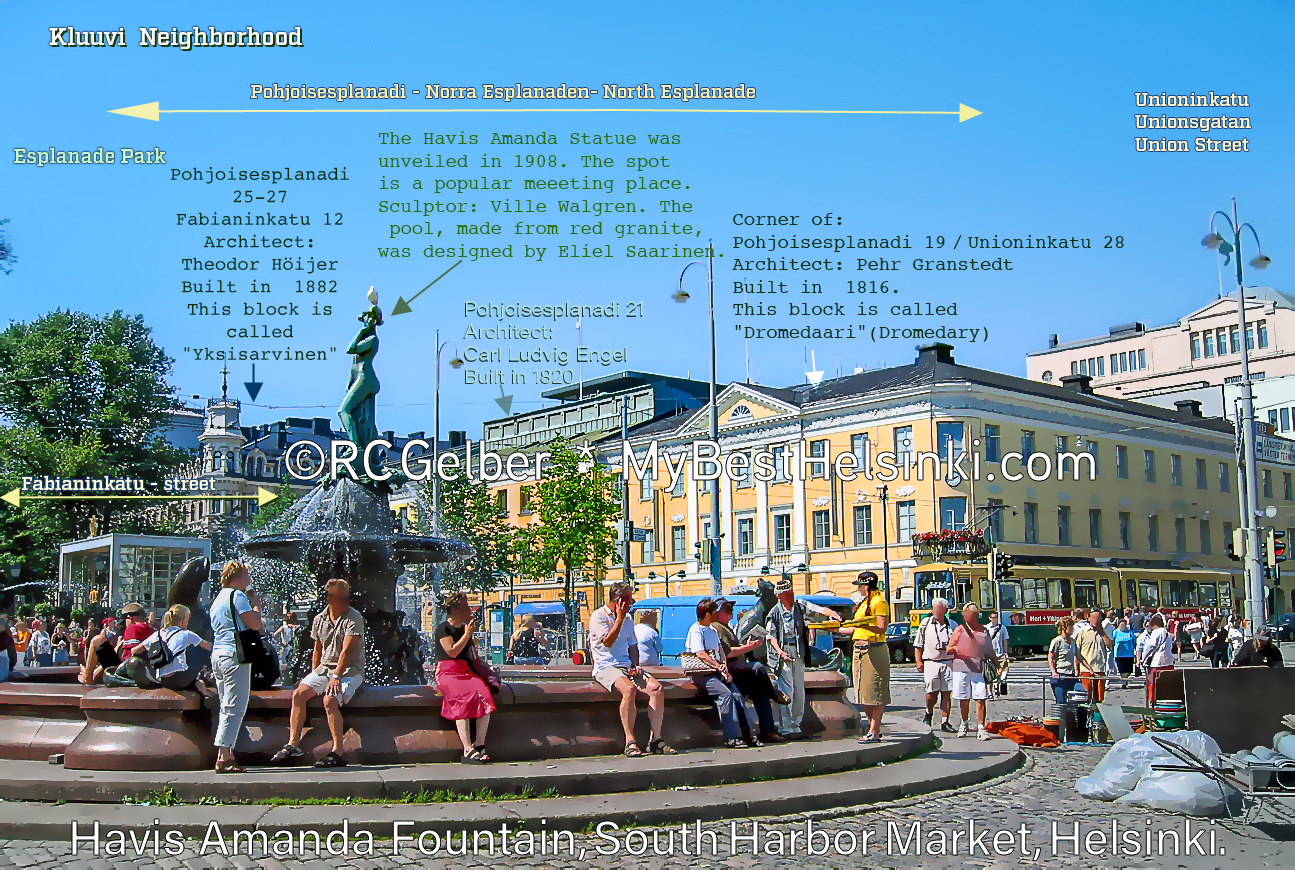 Havis Amanda, is a popular meeting spot, among other things. The tourist office is
located in the Neo-Classical building behind the statue, right under the clock..
Havis Amanda, is a popular meeting spot, among other things. The tourist office is
located in the Neo-Classical building behind the statue, right under the clock..
Close to the Senate and Market Squares you can
see the Russian-Byzantine
style
Uspenski Cathedral,
designed by Aleksander M. Gornostajev and built in
1868. It is the largest Eastern
Orthodox church in Europe. second link
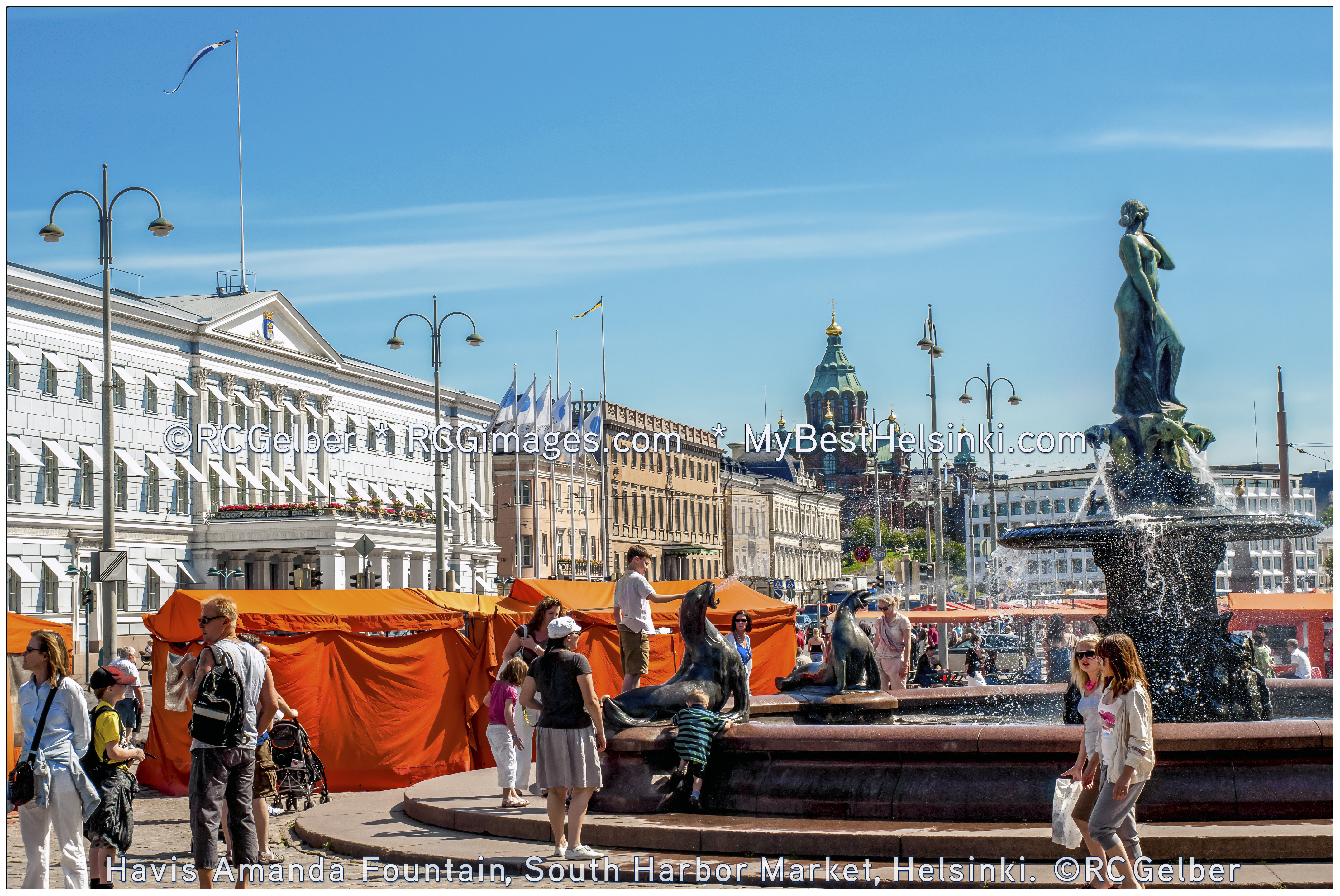
Image & more info about Uspenski Cathedral further down on this page.

Pohjoisesplanadi 9
Architect: Pehr
Granstedt. Built in
1815 Block:
Elefantti (Elephant)
Built in 1839
Architect:
A.F. Granstedt
Architect:
Pehr Granstedt
Built in 1817
Pohjoisesplanadi 3
Block: Leopardi
(Leopard, Panther)
Pohjoisesplanadi 1 -
Mariankatu 2
Architect: Carl Ludvig Engel
Built in 1843
Block: Leopardi
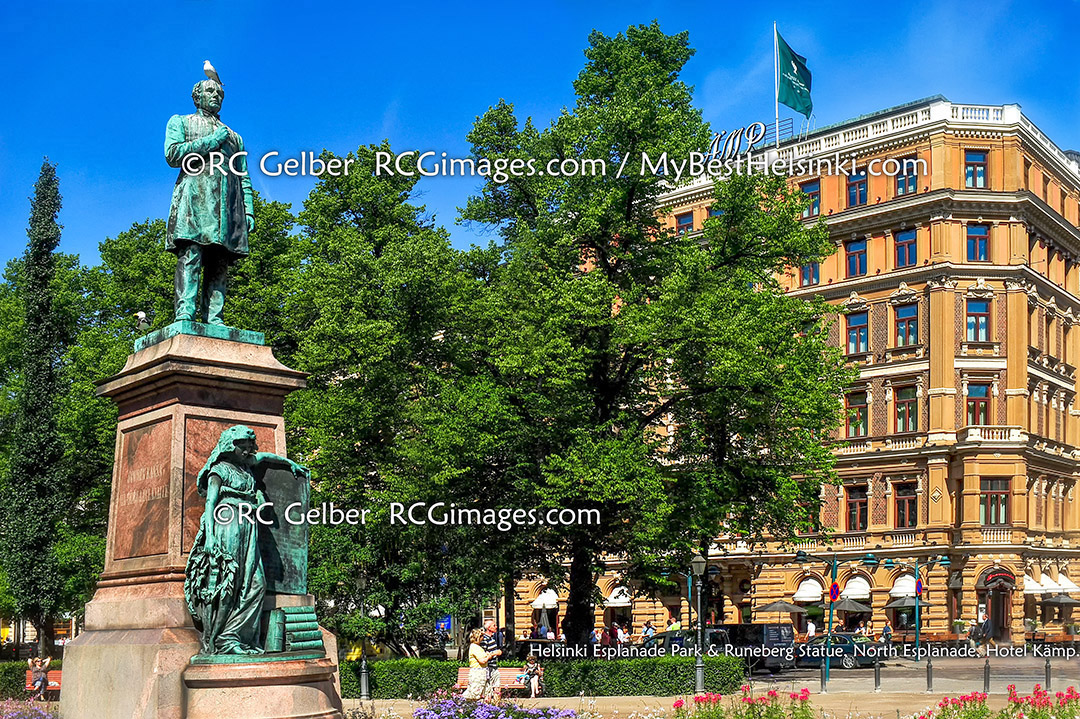
TÖÖLÖ BAY, LINNUNLAULU NEIGHBORHOOD:
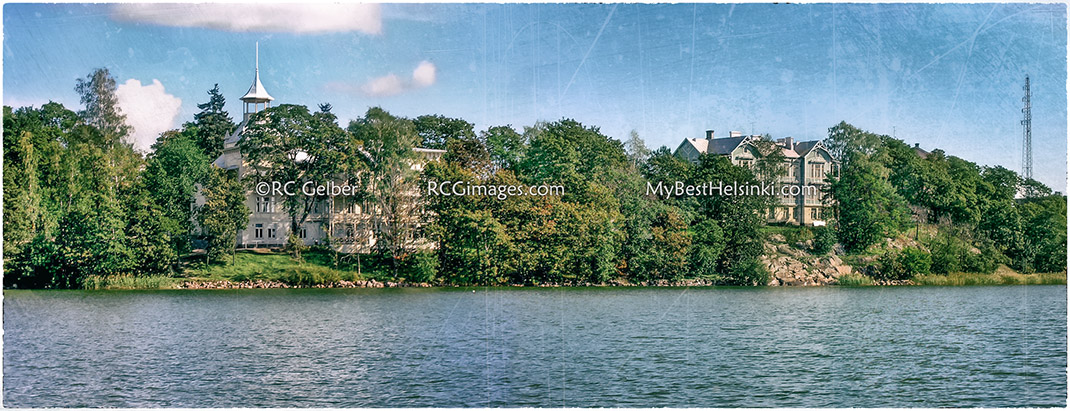 The old wooden villas, Villa Kivi and the Blue Villa, overlooking Töölö Bay.
The old wooden villas, Villa Kivi and the Blue Villa, overlooking Töölö Bay.
The Linnunlaulu
(“Birdsong”,
“Fågelsång”) Villa Area lies on
the eastern side of Töölönlahti Bay,
technically in Kallio Borough. The ornate villas were built
mostly between the 1870s and the 1880s.
Villa Kivi
was designed by architect
Selim Lindqvist in 1890.
It has been renovated into a home for writers.
The café in the Blue Villa has
a great view over Töölönlahti Bay.
A VIEW OF THE CENTER OF HELSINKI THAT VISITORS RARELY GET TO SEE.
Töölö Bay, with Villa Kivi on left, overlooking the bay, Töölö neighborhood & the Helsinki Center:

Helsinki's center is quite beautiful and Helsinki is adamant on maintaining its low (literally) profile. This is Töölö Bay, looking toward the center. Behind the fountain, you can see the tower of the National Museum (Kansallismuseo). Immediately to the left of the fountain, is Finlandia House. Designed by Alvar Aalto. A bit more to the left, you might be able to make out the rounded roof of Kiasma, the museum of contemporary art. Next left is the Sanomatalo building.
KATAJANOKKA NEIGHBORHOOD:
ART NOUVEAU ("Jugend") ARCHITECTURE originated in the 1880s and blossomed in Helsinki. Largely inspired by the national epic "Kalevala" it took a local form called national romanticism. A good example of this style is the National Museum (Kansallismuseo), that was designed by architects Herman Gesellius, Armas Lindgren & Eliel Saarinen. Another example of Art Nouveau ("Jugend") architecture (a later form of this style), is the Helsinki railway station, designed by Eliel Saarinen.
Katajanokka hosts many gorgeous JUGEND (Art Nouveau) buildings: ... and also an impressive Russian-Byzantine style cathedral:
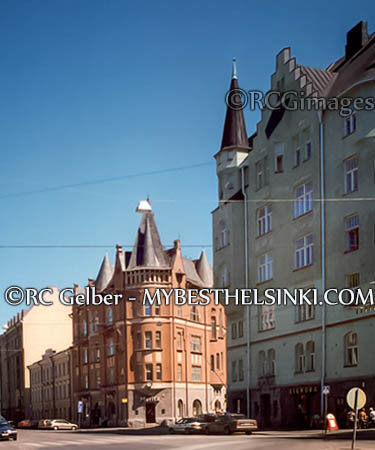
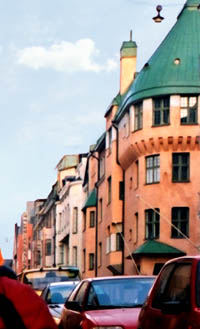
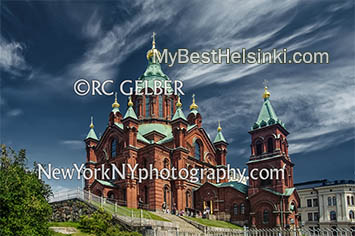
The building of Uspenski Cathedral.
Link to Museum of Finnish Architecture's great Art Nouveau photo pages.
The brown building, "Tallberg", in the center is on the corner of Satamakatu & Luotsikatu. Built in 1898, and designed by architects: Herman Gesellius, Armas Lindgren & Eliel Saarinen. This block is called "Lehtikuusi".
in 1904 and designed by architects
von Essen, Kallio & Ikäläinen.
This block is called "Leppä".
Location: The corner of Luotsikatu
& Katajanokankatu.
A mixture of Art Nouveau, Neo-Classicism & Neo-Reneissance...
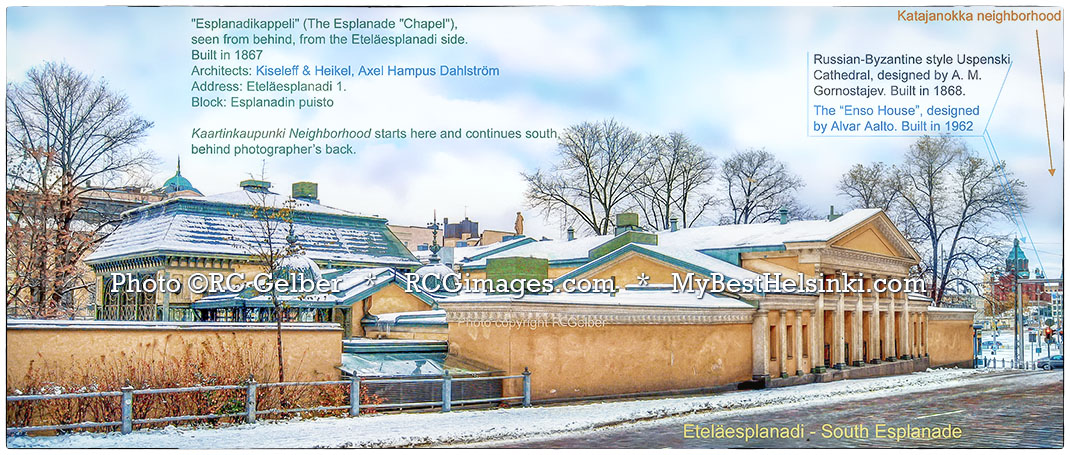
Address: Eteläesplanadi 1. This block is called -surprise- "Esplanadin puisto" (Esplanade Park). Let's turn around and walk deeper
into the neighborhood:
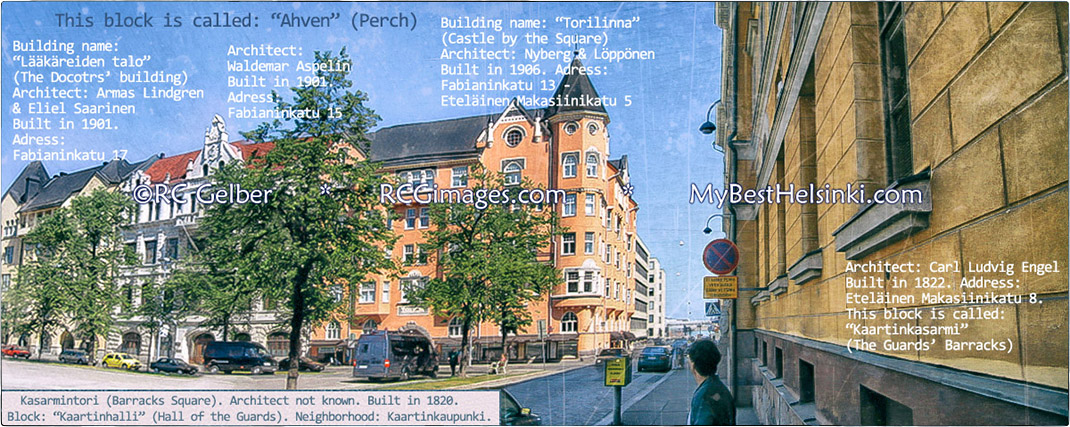
Kasarmintori is surrounded by buildings that were designed by some of the greatest architects in Helsinki:
C.L. Engel, Herman Gesellius, Armas Lindgren, Eliel Saarinen, Waldemar Aspelin, G.W. Nyberg & Löppönen.
MUSEUM OF FINNISH ARCHITECTURE Address: Kasarmikatu 24, 00130 Helsinki. Phone: (358) (0)9 8567 5100
If you walk down the street in the above image, you will arrive at Eteläranta Street by the South Harbor. There you find this lovely landmark: The yellow and red Vanha Kauppahalli (Old Market Hall). Built in 1889. Architect: Gustaf Nyström. Make sure to at least stroll through it. You might decide to stop for a snack or great coffee...
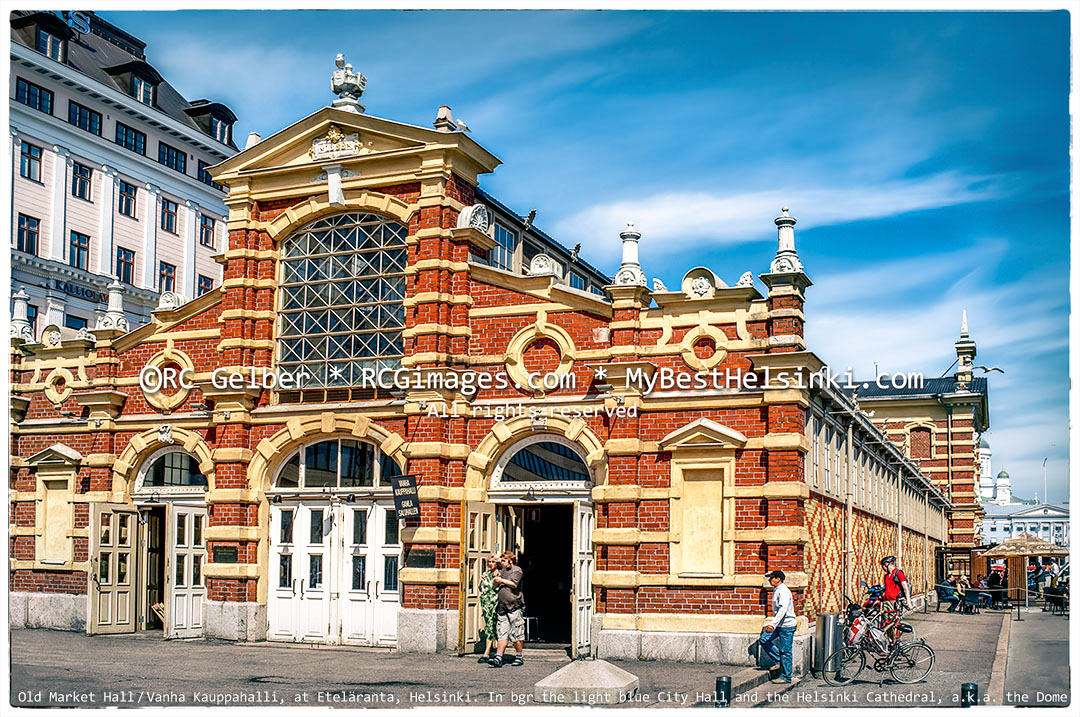
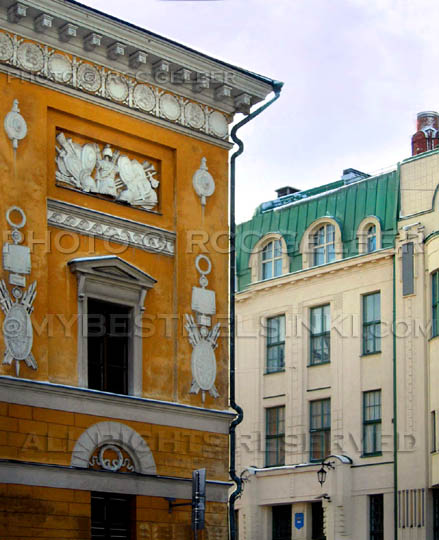
-Yellow
building to left: architect C.L.Engel. Built: 1822
Eteläinen
Makasiinikatu 8. Block: Kaartin kasarmi.
-Light colored building, right: architect Selim A. Lindqvist.
Built: 1909,
Building name:"Sähkölaitos" Kasarmikatu 30-32,
block: Sampi
The RIKHARDINKATU LIBRARY.
Built in
1881, it was the first building that was designed specifically
to be
a library. The library was designed by architect Carl Theodor
Höijer, who's
Neo-Renaissancebuildings are still an integral
part of Helsinki's city image.
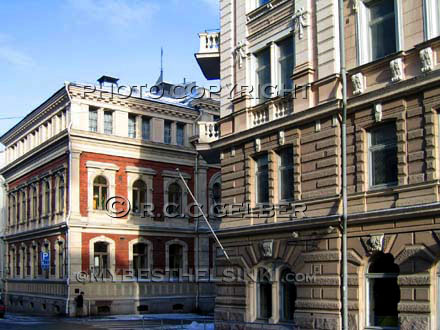
In the
1920's, with the
help of architect Runar Eklund, another
floor a new
stairwell
were
added. Along the years more changes were made and the
building lost a
large part of its original image.
Rikhardinkatu Library. On the upper right of the library page there is a list of all Helsinki Libraries.
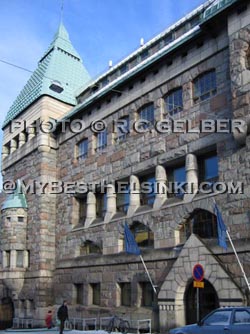
Building
name: "Puhelinlaitos"
Korkeavuorenkatu 35. Architect: Lars Sonck.
Built: 1905. Block name: Sampi.
Click image for larger photo:
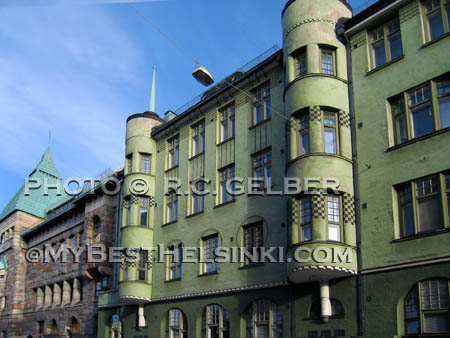
Green building name:
"Kastén". Korkeavuorenkatu 31-33.
Architect: Emil Svensson, Emil Holm.
Built: 1907, Block: Sampi
Click image for larger photo.
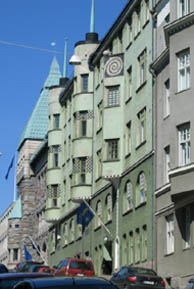
Click image for larger photo:
"Firehouse", at Korkeavuorenkatu 26. Architect: Theodor
Höijer.
Built in 1891. Block: Miekkakala (swordfish).
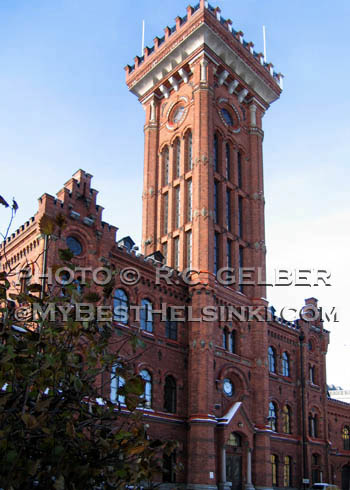
This building is basically across the street from the grey
Neoo-Rmantic stone castle; "Puhelinlaitos", shown above.
_________________________
Meanwhile, back to the South Harbor / Katajanokka area. An
ominous looking, pink sunset cloud looming in the horizon
behind Katajanokka and the historic Uspenski Cathedral: 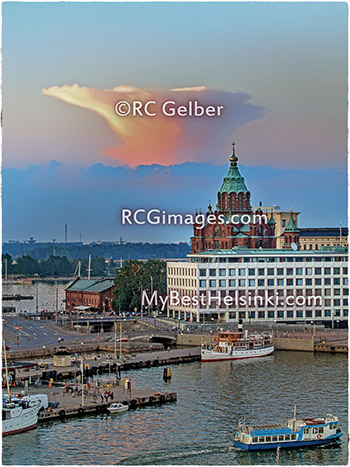
Click on image for area and building information on a large
version of the image.
The grey building, "Neodomus", second from right, at Korkeavuorenkatu
29, was built in: 1907. Architect: Gunnar Stenius. Block name: Sampi.
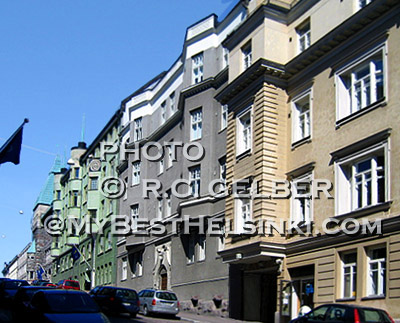
The building on far right, on the corner of Korkeavuorenkatu
& Pieni
Roobertinkatu (at Pieni Roobertinkatu 5), was built in 1906.
Architect not known.
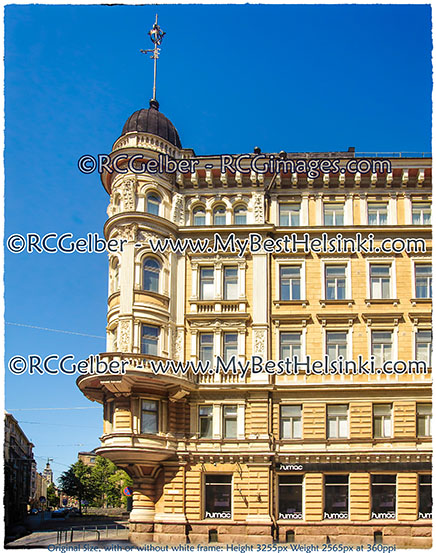
"Spennertin talo" (Spennert building) at the corner of Erottajankatu 1-3 & Pieni Roobertinkatu 13. You can see a part of the "Diana Park" in the bgr.
Architect: August Nordberg. Built in 189. Block: Miekkakala (Swordfish)
TÖÖLÖ NEIGHBORHOOD:
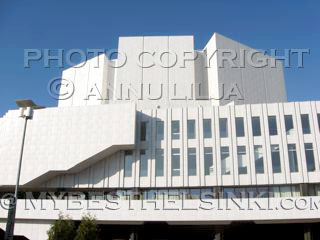
Finlandia House, in Töölö. Architect Alvar Aalto.
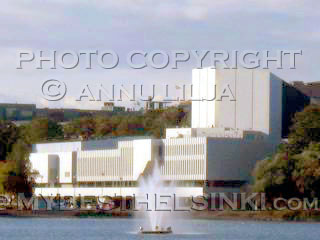 A small part of Töölö neighborhood.
Early morning by Töölö Bay: fountain & Finlandia house
A small part of Töölö neighborhood.
Early morning by Töölö Bay: fountain & Finlandia house
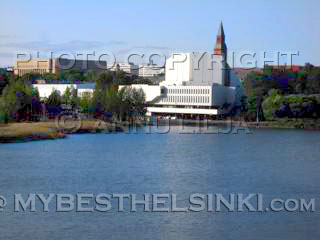 Large, brown building, far left: The Parliament building (1931),
designed by architect Johan Sigfrid Sirén. Finlandia
House in front, and the tower of the National Museum
rises behind it. (see information, below.)
Large, brown building, far left: The Parliament building (1931),
designed by architect Johan Sigfrid Sirén. Finlandia
House in front, and the tower of the National Museum
rises behind it. (see information, below.)
Functionalism in architecture (and art), was developed in the early 1900's. It is associated with the modernist movement that originated in the second quarter of the 1900's.
Good examples of Functionalism in Helsinki, are the Helsinki Olympic Stadium (1952 Olympics) and Lasipalatsi (the "Glass Palace") on Mannerheimintie, one block up from the Railway Station.
Famous examples of early modernism in Helsinki are the Finlandia House (architect: Alvar Aalto) and the "Rock Church" (Temppeliaukion kirkko), (architects: Timo & Tuomo Suomalainen). Rock Church website.
Academic Bookstore, designed by Aalto: some images on Pinterest. |
More Aalto images on Pinterest.
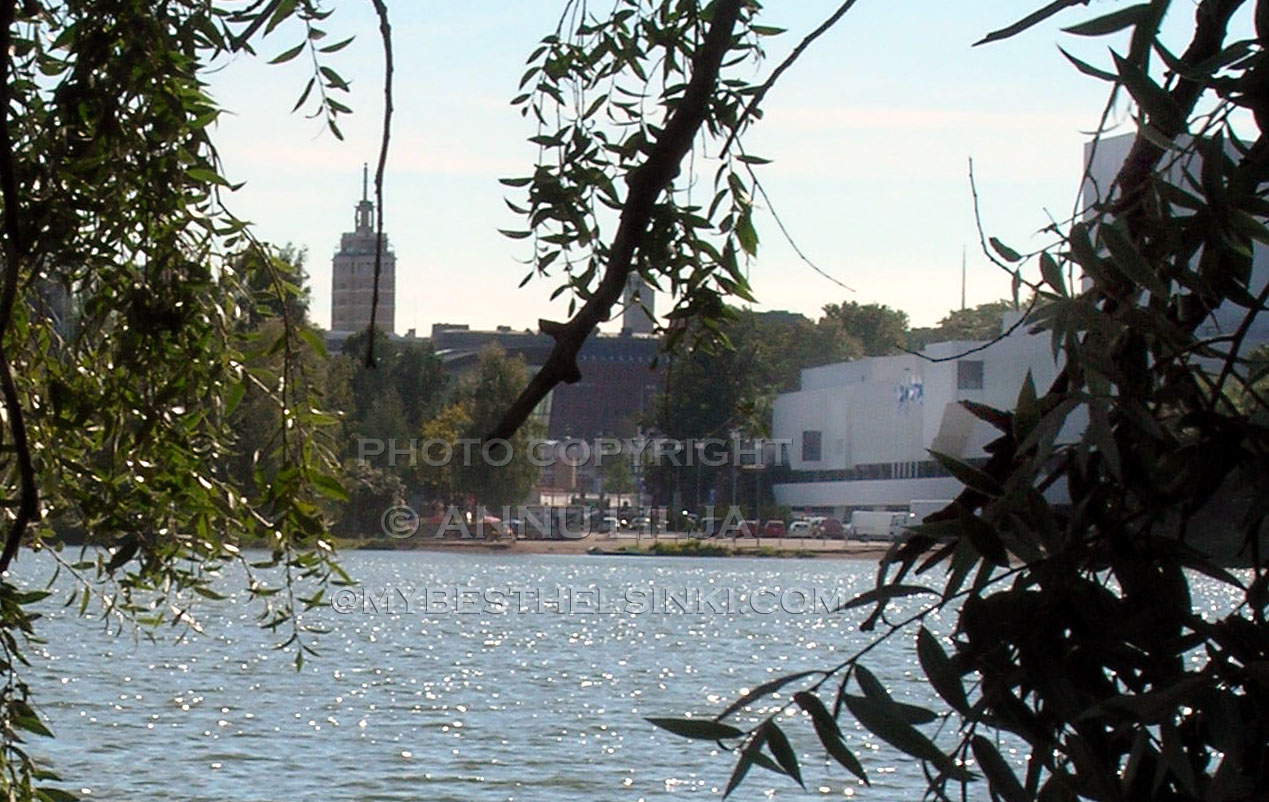
The White Finlandia House, located between Töölö Bay & Mannerheimintie.
Click for large view with building names.
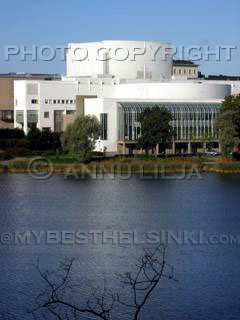
Architects: Eero Hyvämäki, Jukka Karhunen & Risto Parkkinen. Built in 1993
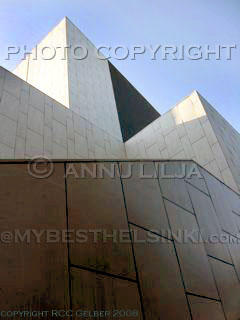
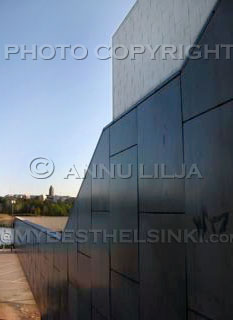
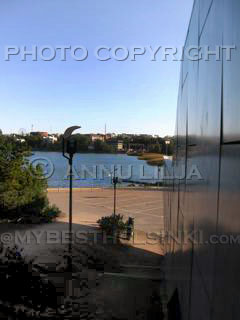
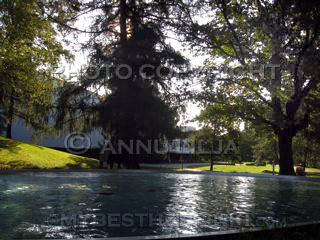 The Finlandia House, behind the trees, is in a
parklike setting, between Mannerheimintie -street,
a small park and the Töölö Bay. This droplet shaped
pond is part of an art installation.
This whole area is very popular with joggers, especially
the ones that live in Töölö.
The Finlandia House, behind the trees, is in a
parklike setting, between Mannerheimintie -street,
a small park and the Töölö Bay. This droplet shaped
pond is part of an art installation.
This whole area is very popular with joggers, especially
the ones that live in Töölö.
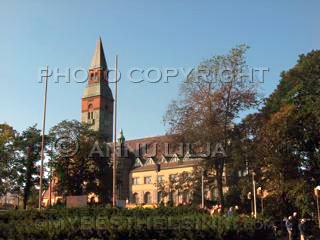 ART NOUVEAU ("Jugend") architecture originated in
the 1880s and blossomed in Helsinki. Largely inspired
by the national epic "Kalevala" the style took a local
form called National Romanticism. The National
Museum (Kansallismuseo), designed by architects
Herman Gesellius, Armas Lindgren & Eliel Saarinen,
is a good example of National Romanticism. second link
ART NOUVEAU ("Jugend") architecture originated in
the 1880s and blossomed in Helsinki. Largely inspired
by the national epic "Kalevala" the style took a local
form called National Romanticism. The National
Museum (Kansallismuseo), designed by architects
Herman Gesellius, Armas Lindgren & Eliel Saarinen,
is a good example of National Romanticism. second link
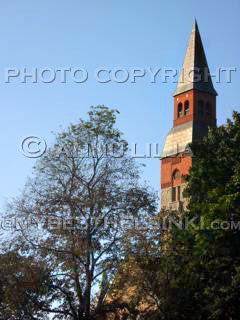
The National Museum, built in the National
Romantic style.
KLUUVI NEIGHBORHOOD:
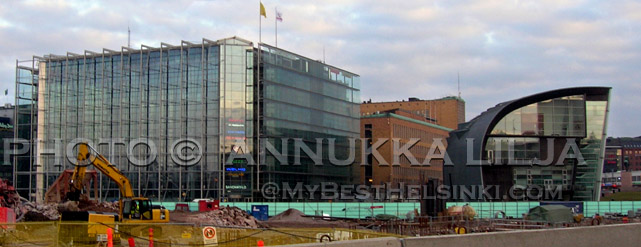
Kluuvi, as seen from Töölö Bay. Click photo for larger vu:
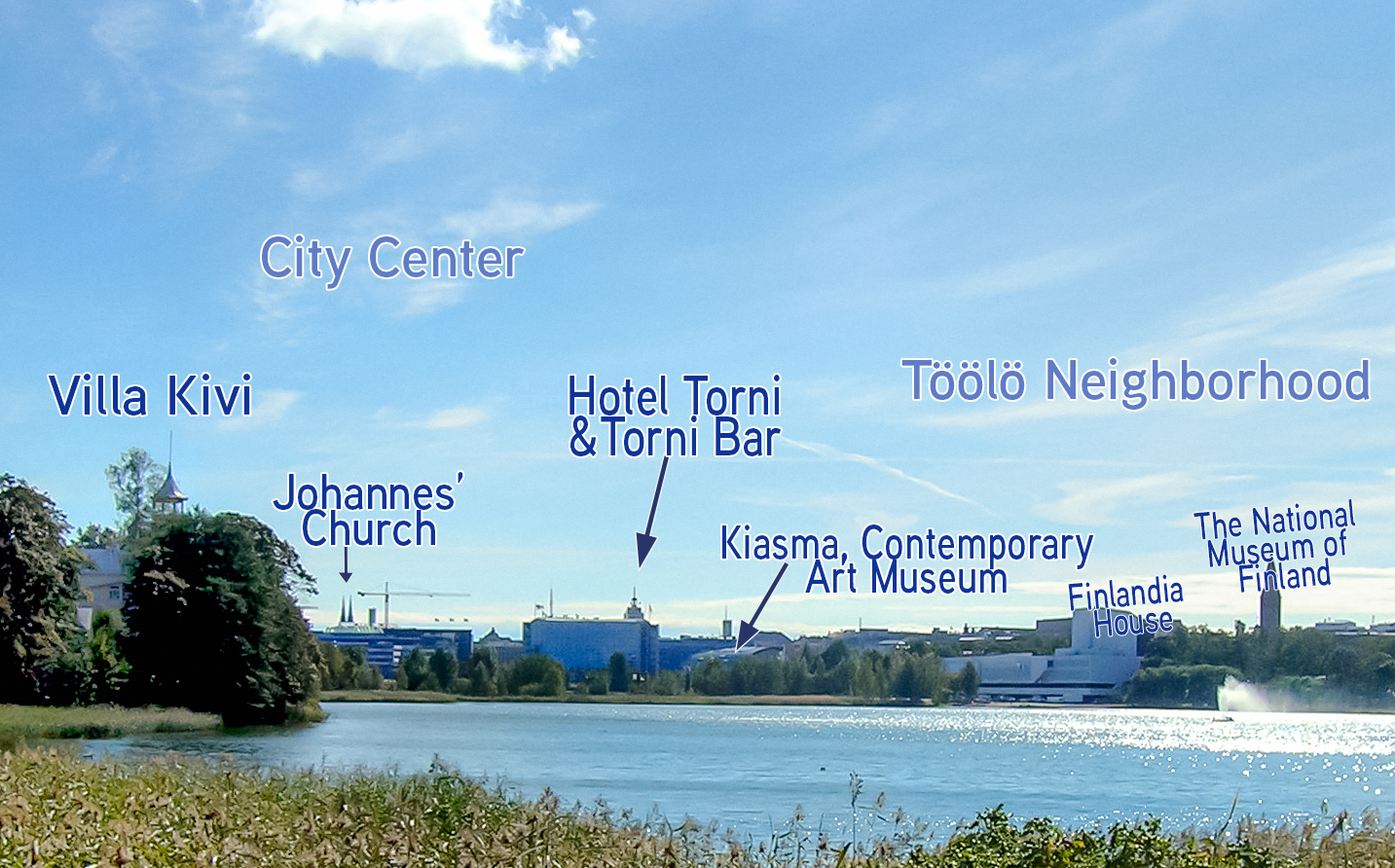
LEFT: Kiasma was designed by the American architect
Stpehen
Holl. Built: 1996-.
Sanomatalo was designed by
architect
Anti- Matti Siikala. Built:1999.
Sanomatalo is a business
building that also houses exhibition spaces, some stores
and a restaurant & café which is a popular meeting
spot.
Several news magazines have their offices in the building.
The Helsinki Railway Station and it's surroundings, also in "Kluuvi":
A later form of Art Nouveau ("Jugend") architecture: Helsinki Railway Station, designed by Eliel Saarinen. and built 1914. Located at Kaivokatu 1, in Kluuvi neighborhood. This block is called -surpirse!- "Rautatieasema" (Railway Station )
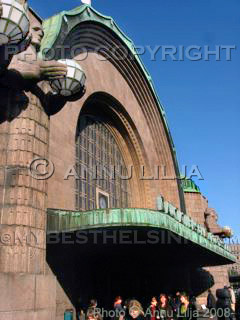
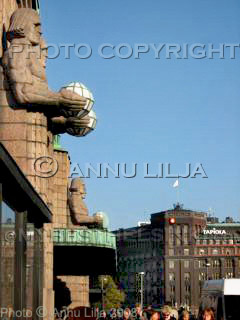
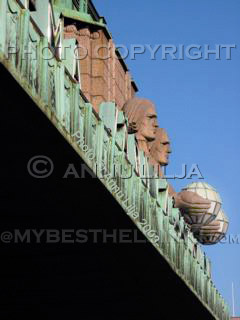
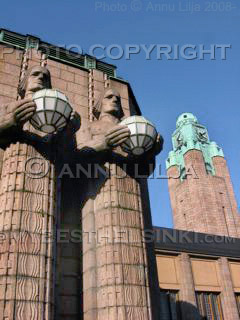
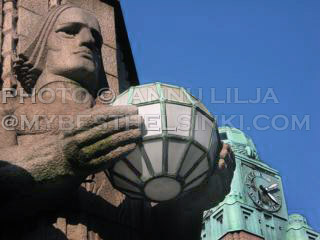
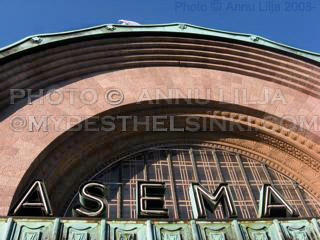
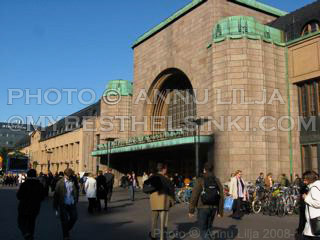
Looking East, toward Kaisaniemi neighborhood from the Railway Station:
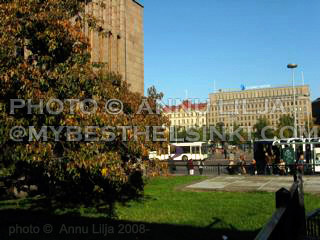
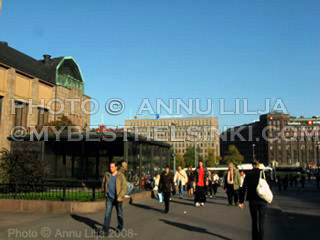
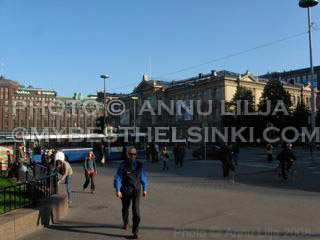 Building on right: Ateneum Art Museum.
Building on right: Ateneum Art Museum.
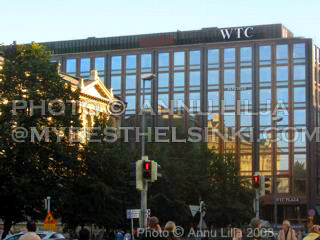 Ateneum and the Helsinki WTC.
Ateneum and the Helsinki WTC. 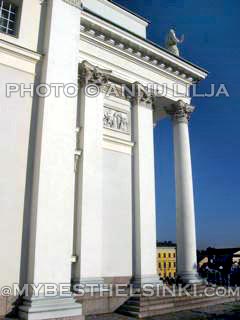
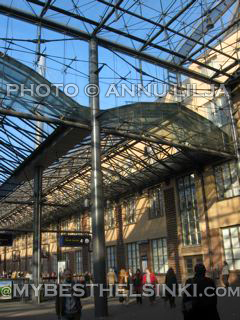
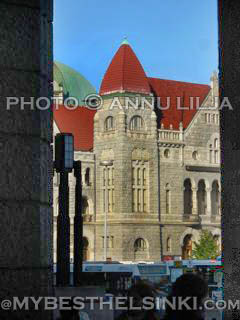
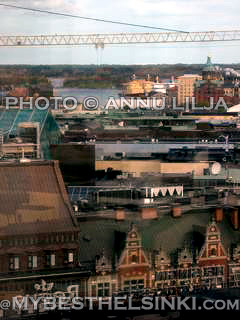
KLUUVI NEIGHBORHOOD continued: Mannerheimintie - Mannerheim Street & the Esplanade area:
The very center, on Mannerheimintie: Far left you can sort of see the tower of the National Museum (Kansallismuseo). The next four images, below, show the real order of all the shown buildings along the very beginnig of Mannerheimintie (Mannerheim Street) - Mannerheimvägen.
The Old Student House (low yellow building) was
designed by architect Axel Hampus Dahlström and built in 1870.
The New Student House (w. green
cupola) was designed by architects Armas Lindgren & Wivi Lönn, and built in 1910.
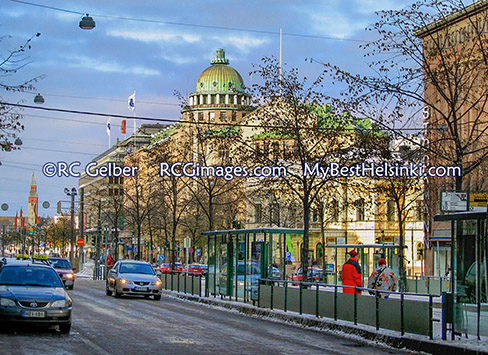 Far right, corner of Stockmann. Dark building w. flags: Sokos & Vaakuna Hotel. The block is named "Soopeli" and we are in Kluuvi neighborhood.
Far right, corner of Stockmann. Dark building w. flags: Sokos & Vaakuna Hotel. The block is named "Soopeli" and we are in Kluuvi neighborhood.
Stockmann - the Argos building was built in 1897 and designed by architects: Grahn, Hedman & Wasastjerna & John Settergren. We are still in Kluuvi neighborhood and this
Street).
Location: corner of Pohjoisesplanadi 25-27 (North Esplanade) and Fabianinkatu 12 (Fabian Street).
This Neo-Renaissance building, called the "Grönqvist building", was built in 1882 and designed by architect Theodor Höijer.
The decorative facade was designed by sculptor Karl Magnus von Wright.
The Esplanade Park, which spans from Mannerheimintie Street all the way to the South Harbor Market Square, lies between the North Esplanade and the South Esplanade.
This block is called "Unicorn"
("Yksisarvinen", Swe: "Enhörningen).
The neighborhood is called "Kluuvi".
Click on image for a much larger view.
Wider, late summer night (almost
midnight) view of the Grönqvist
Building (which spans a whole block).
Address: Pohjoisesplanadi 25-27 -
Fabianinkatu 12 &
Kluuvikatu 1,
00100 Helsinki
Architect: Theodor Höijer
Style: Uusrenesanssi /
Neo-Renaissance
Built in: 1882
Neighborhood: Kluuvi
Block: Yksisarvinen (Unicorn) -
( Swe:"Enhörningen)
Click on image for a larger view.
Back to KAARTINKAUPUNKI NEIGHBORHOOD:
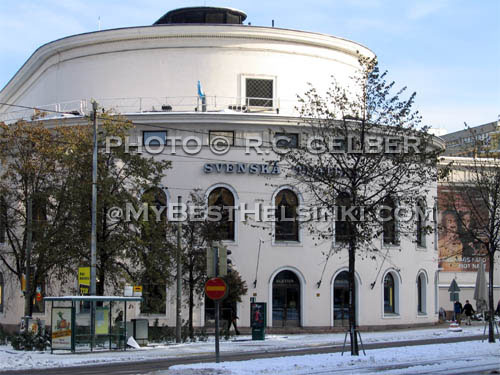
The Swedish Theater was built in 1866 & designed by architects: Jarl Eklund, Nikolai Leontievitj Benois, Eero Saarinen. We have crossed over to Kaartinkaupunki neighborhood. This block is called -you guessed it- "The Swedish Theater".
Corner of Eteläesplanadi & Erottajankatu. It is also the beginning of Mannerheimintie (Mannerheim
Street), which begins by the traffic light. This colorful corner building was designed by architect: Theodor Höijer and was built in 1892. The block is called "Hauki" (Pike). The neighborhood is "Kaartinkaupunki".

KAMPPI NEIGHBORHOOD:
The Old Church Park, framed by buildings on Lönnrotinkatu, Yrjönkatu & Bulevardi streets. CLICK on PHOTO. Below, the architects that designed these buildings:

Carl Ludwig Engel (Old Church), Armas Lindgren, Flor Granholm, Unknown (at least to us), Sigurd Forsterus, Theodor Granstedt & Sebastian Gripenberg.
The pretty building that belongs between the two photos, can be seen in the center photo below (far right in photo): it was designed by architect Waldemar Aspelin.
KLUUVI NEIGHBORHOOD of old Helsinki, by South Harbor Market Square and North Esplanade - now called Tori Korttelit / Market Square Quarters:
The Yellow corner building (with the big clock) houses the Helsinki Tourist Information office. Address: Pohjoisesplanadi 19 - Unioninkatu 28, 00100 Helsinki.
Architect: Pehr Granstedt. Built in: 1816 Neighborhood: Kluuvi. Block: Dromedaari. Market Square Quarters / Tori Korttelit web-pages.
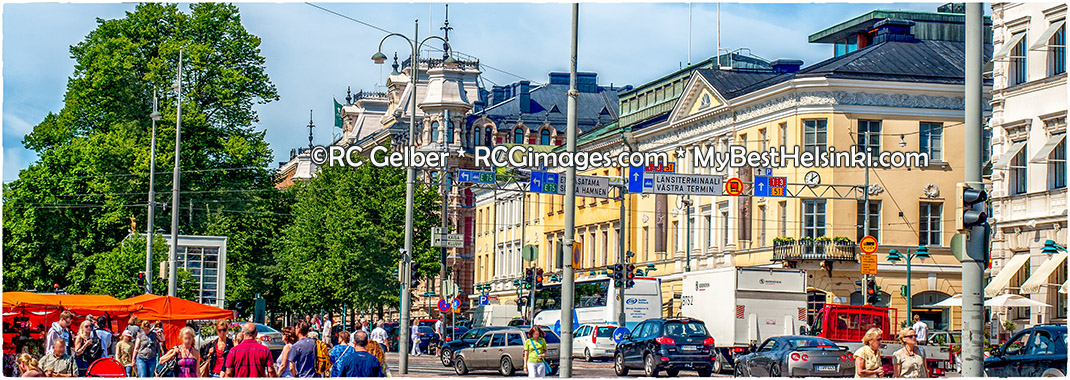
Kauppatori South Harbor Market Square looking toward Katajanokka and Uspenski Cathedral. The photo is taken before the ferris wheel and other construction on the Square:
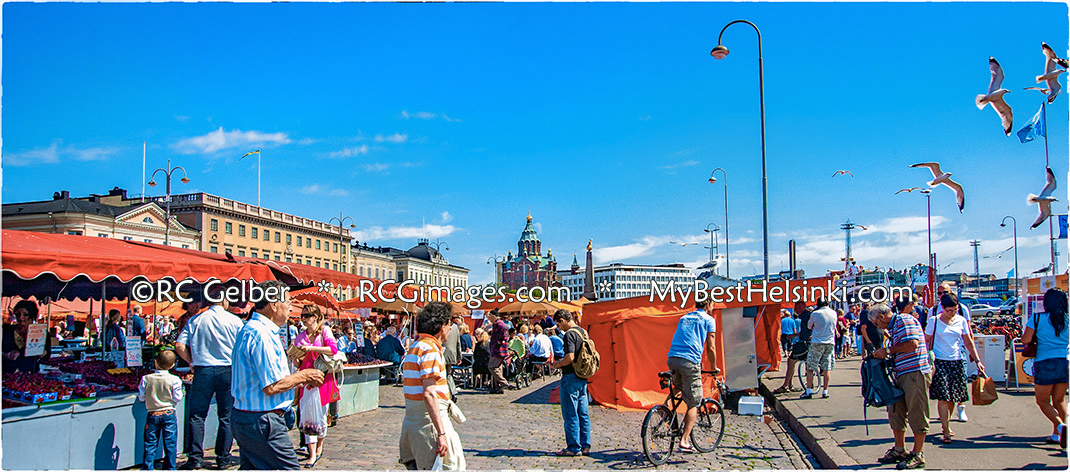
Straight ahead, KATAJANOKKA neighborhood (island) and Uspenski Cathedral, built 1868, architect: Aleksei M. Gornostajev. The white building to the right and in front of the Cathedral is the 1962 "Enso-Gutzeit headquarters building", designed by architect: Alvar Aalto. It replaced the beautiful Norrmén House which was designed by architect Theodor Höijer and built in 1897. Link to historic images of the Norrmen House, which was demolished to make way for the Enso building.
Again, Helsinki's KAARTINKAUPUNKI NEIGHBORHOOD, bordering the South Harbor:
Wow! A STUNNING LINK (by Helsingin Sanomat) to a 360 panoramic view of the center of Helsinki. Click on the red circles on the photos to get info and history and click on the arrows to change the view. Sorry, in Finnish only, but you will get the place names and the architects at least.
MUSEUM OF FINNISH ARCHITECTURE
Address: Kasarmikatu 24, 00130 Helsinki.
Phone: (358) (0)9 8567 5100
ANOTHER FABULOUS LINK that allows you to see the center of Helsinki building by building, with good information.
In Finnish only: Helsinki block by block.
Virtual reality link to historic Helsinki.
Side by side
OLD PHOTOS of Helsinki. Second link for searching photos from a particluar area. Here we typed in "Senate Square".
Here, two photos, published in Helsingin Sanomat, looking over the South Harbor Market Square, along Eteläranta to the old Market Hall and
beyond.
Famous Finnish Architects (and some foreign ones, too)
SAFA: Finnish Association of Architects.
